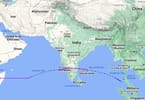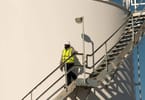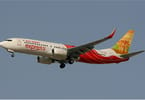You know you are taking off in the Bolivia of President Evo Morales when the leaflet with the safety instructions pictures a woman with the quintessential Andean indigenous combination of pigtails and a flouncy skirt.
Welcome on board Boliviana de Aviacion (BoA), Bolivia’s state-run airline.
“The aim is to democratize air travel, make it affordable for the majority of the people of this impoverished country,” explains Captain Juan Carlos Escobar at the cockpit of one of BoA’s four Boeing 737-300s – an aircraft known as the ‘money-maker’.
A former flight commander in Lloyd Aereo Boliviano (LAB), which was the Andean country’s flagship airline until it went bankrupt in 2006, Escobar feels proud about flying for BoA.
“We are showing the world that if a state-owned company is well-run, it can definitely be sustainable,” Captain Escobar says.
Since taking office in January 2006, the left-wing Mr Morales has nationalised several utilities and commodities companies.
The success of this increasingly state-run economy has been limited. There have been a number of management fiascos, most importantly at the state-run energy company, YPFB, and the economy is struggling to secure foreign investment. Against this backdrop, BoA seems a bright light.
‘Social responsibility’
Since its first flight in March 2009, BoA has taken on board several people that were part of LAB, an airline that in the 1970s and 1980s was highly regarded all over the world. Then LAB was partly privatised and mismanagements and accidents provoked its downfall.
“After the fall of LAB we saw that the market had not only been monopolised but also drawn into a bad quality of service, with irrational prices. So we felt there was a problem, a need and that Bolivia needed some fairness,” Ronald Casso, BoA’s general manager tells the BBC.
“We saw a business opportunity, one that would particularly benefit passengers. We took on the task of increasing the number of users through forms of social responsibility,” he says.
“Basically by allowing air transport to be available for people who had never had the chance of flying, for people in a country with high levels of poverty who might be in desperate need of air transport – today it is crystal clear that more people are flying in Bolivia,” he says.
And that is very evident at the arrivals gate. A first-time air traveller, Gavina Ortega, dressed in an indigenous outfit of bowler hat and thick skirt, emerges from the Cochabamba-La Paz flight and says that she is happy that BoA is in operation.
“I now have an opportunity to fly, BoA is good and affordable. There is no other service of its kind here in Bolivia,” she says.
More routes
South America’s airline industry is marked by the examples of Chile’s Lan and Argentina’s Aerolineas.
Lan offers an example of a path that a state-run airline can follow in order to become a world-class one. Aerolineas is an example of what not to do: it has fallen on hard times (and lost face) on several occasions in the recent past.
BoA admits that it is sandwiched between those two examples. But that has not stopped it from deciding to add more aircraft and routes.
It has recently started flying to Buenos Aires. It will soon start operations to Sao Paulo, with Lima to follow soon after. There is a possibility that flights to Miami and Madrid will follow.
BoA started with only $15m (£9.8m) and with the aim of occupying the middle ground between low-cost airlines and regular commercial airlines with their excellent levels of service. Its managers say that, on the cost side, they closely followed the examples of Easyjet in the UK and Brazil’s Azul and, in terms of service, British Airways.
BoA offers no business class, something that fits within its concept of democratising air travel in what is one of South America’s poorest countries.
“For long flights, I do see the point [of business class]. In the case of short flights, business class is a form of discrimination, for some people to show off and others to feel inferior when the curtain in front of them closes off,” Mr Casso says.
Before BoA took to the skies in March 2009, 1.2 million travellers passed through Bolivian airports a year. The entrance of BoA has opened 900,000 more seats.
‘Evo Airlines’
This transformation has caused a great deal of friction. BoA’s main rival, the privately-owned Aerosur (which BoA has accused of acting like a monopolist in the past) has been crying foul since BoA started operating.
“BoA has put a lot of new seats into a market that does not need them. It has forced down prices by setting fares that are below costs thanks to government funding. That is called dumping and it is illegal. But because it is owned by this particular government, no one can say a thing,” says Gerardo Lopez, one of Aerosur’s senior managers.
“What BoA is doing is to prostitute the market. And it is aimed at monopolising the market, personally by the president and its allies… This is a political battle because this government cannot stand private business,” he adds, explaining how the government’s watchdogs monitor them closely.
Echoing Mr Lopez’s comments, some ironically refer to BoA as ‘Evo Airlines’.
However, others see BoA as a necessity and an airline that is bound to grow. Among those is Nathalie Calenge, one of BoA’s air stewards and a former employee of Korean Air and Air France.
“If we think that the country’s capital airport [located in the satellite city of El Alto] is crowned at just over 4,000m above sea level, Bolivia is very close to the sky,” she says.
“So for BoA the sky cannot be the limit; the limit is far beyond.”
WHAT TO TAKE AWAY FROM THIS ARTICLE:
- A first-time air traveller, Gavina Ortega, dressed in an indigenous outfit of bowler hat and thick skirt, emerges from the Cochabamba-La Paz flight and says that she is happy that BoA is in operation.
- In the case of short flights, business class is a form of discrimination, for some people to show off and others to feel inferior when the curtain in front of them closes off,”.
- “Basically by allowing air transport to be available for people who had never had the chance of flying, for people in a country with high levels of poverty who might be in desperate need of air transport –.






















